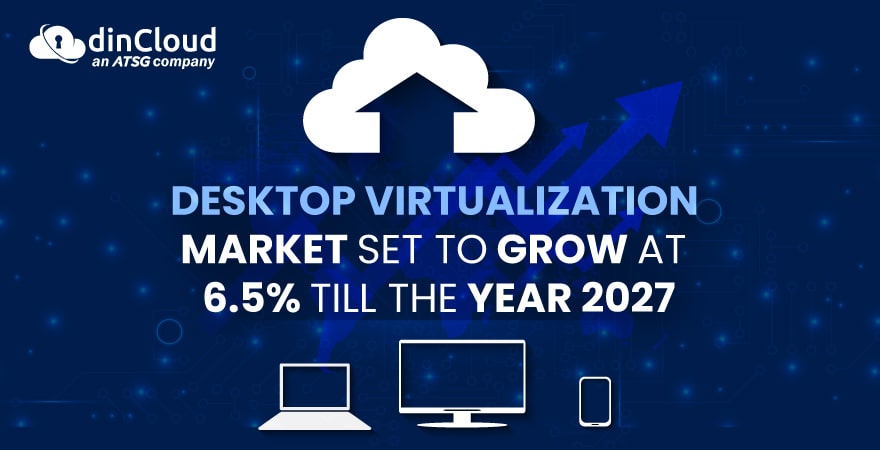Enterprises are rapidly turning towards Desktop Virtualization technologies for a multitude of workloads. Virtualization is delivering enterprises the flexibility, scalability and reliability they expect in today’s hybrid workforce models.
Recently, a study was conducted on the global desktop virtualization market by 360 Research Reports. The company has a wealth of experience in the technology sector in general, and the Cloud Computing market in particular.

In the research report, the company has forecast a very healthy, and consistent growth rate for Desktop Virtualization technologies globally. As per the report, the global desktop virtualization market will grow at a rate of 6.5%.
Related: The Evolution of Digital Technologies in 2022; thru Deloitte’s Lens
The research covers the period from the year 2021, till 2027 in its recent forecast. According to the company’s estimates, the desktop virtualization market will exhibit a Compound Annual Growth Rate (CAGR) of 6.5% during the forecast period.
As per the research report, the total size of the global desktop virtualization market during the year 2021 was US $78.5 Billion. Given the forecast CAGR of 6.5%, the size of the global desktop virtualization market is expected to reach a whopping US $122.3 Billion by 2027.
One of the most defining elements of this report, and the optimistic growth forecast for the global desktop virtualization market is that it duly incorporates the impact of the global Covid-19 pandemic.
In the report, the catalytic growth of desktop virtualization technologies has been attributed to businesses transitioning towards remote work scenarios. Now, enterprises will full on remote work infrastructures are pivoting towards hybrid workforce models.
According to the report, hybrid work models will put IT decision makers in a tough spot, as it is next to impossible to tune legacy, on-premise IT infrastructures for hybrid work. Most legacy IT infrastructures are designed around full-on work from office scenarios.
Related: Why & How are Enterprises Moving towards Green IT in 2022?
Legacy IT infrastructures are completely incapable of delivering the flexibility, functionality and scalability that is associated with virtualized desktop environments. The report further dives into the major desktop virtualization models, and their pros n cons.
The Major Desktop Virtualization Models
360 Research Reports duly takes into account all the three major desktop virtualization models, namely Desktop as a Service (DaaS), Virtual Desktop Infrastructure (VDI) and Remote Desktop Services (RDS).
In the DaaS model, a specialized Cloud Service Provider (CSP) like dinCloud provides Virtual Desktops hosted out of its data center(s). The DaaS model rids deploying enterprises of the costs and hassle normally associated with on-premise IT infrastructures.
The other desktop virtualization model that the report discusses is Virtual Desktop Infrastructure or VDI. This virtualization model also offers virtual desktops, but these are hosted out of an on-premise data center.
Related: Why Moving to Cloud Computing Still Makes Sense in 2022?
Under the VDI model, the deploying enterprise enjoys almost full, or maximum control and governance over its data. The downside however is the exorbitantly high cost of procuring, and then maintaining on-premise IT infrastructure as well as hardware resources.
The research report also take a deeper dive into Remote Desktop Services (RDS), another basic model for desktop virtualization. However, RDS emerges as the underdog in all this comparison, owing to a lot of cyber security related vulnerabilities.
Desktop as a Service (DaaS) – The Go-To Desktop Virtualization Model
The research report concludes that among the three mainstream desktop virtualization models cited above, Desktop as a Service (DaaS) will emerge as a clear winner. Rather, the report points out that DaaS will be the major driving force behind this healthy growth.
Related: The Trend of Cloud Adoption to Retain its Momentum in 2022
The flexibility, security, reliability and scalability that is offered by DaaS solutions is no match for either Virtual Desktop Infrastructure (VDI) or Remote Desktop Services (RDS). So, it makes a lot of sense that DaaS will be driving the overall growth in desktop virtualization.
Conclusion
In the end, the research report takes into account the enterprises that will be generating most of the demand for DaaS solutions globally. It is forecast that Small to Medium sized enterprises (SMEs) will be the central driver of this high growth rate.
The report further narrows down that this recent growth in desktop virtualization technologies will be centered on the strong demand originating from the Asia Pacific region. SMEs across this region are rapidly pivoting towards DaaS solutions.
The research report paints an optimistic picture regarding the growth of desktop virtualization technologies in general, and DaaS in particular. It is even more encouraging to note that this growth momentum will continue till the year 2027.
Contact dinCloud, an ATSG company, for leading Desktop as a Service (DaaS) solutions for your enterprise needs.


